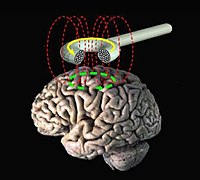
Photo from wikipedia
INTRODUCTION We explored the conditioning effect of a percutaneous electrical pulse of the femoral nerve on cortical motor evoked responses in the rectus femoris muscle. METHODS Corticospinal excitability of rectus… Click to show full abstract
INTRODUCTION We explored the conditioning effect of a percutaneous electrical pulse of the femoral nerve on cortical motor evoked responses in the rectus femoris muscle. METHODS Corticospinal excitability of rectus femoris muscle was measured in sixteen healthy subjects, when a single transcranial magnetic pulse was preceded by an electrical femoral nerve stimulus, using twelve inter-stimulus intervals (from 10 to 275ms). We also evaluated the effects of the intensities of the transcranial magnetic and of the electrical pulses. RESULTS Quadriceps motor evoked potentials were inhibited and facilitated when a single femoral nerve electrical stimulus was delivered at inter-stimulus intervals of 25ms and 150ms, respectively. The facilitation was reduced when low electrical intensity was used, while the inhibition decreased with high intensity transcranial magnetic pulse. CONCLUSION Afferent inputs of a femoral stimulation modulate the responses elicited by transcranial magnetic pulses of the contralateral quadriceps motor cortex. This modulation indicates a sensorimotor integration of proximal lower limb muscles that may be mediated via different types of afferents. This could be of relevance for studies that explore the role of lower limb muscles in postural control and balance.
Journal Title: Neuroscience Letters
Year Published: 2017
Link to full text (if available)
Share on Social Media: Sign Up to like & get
recommendations!